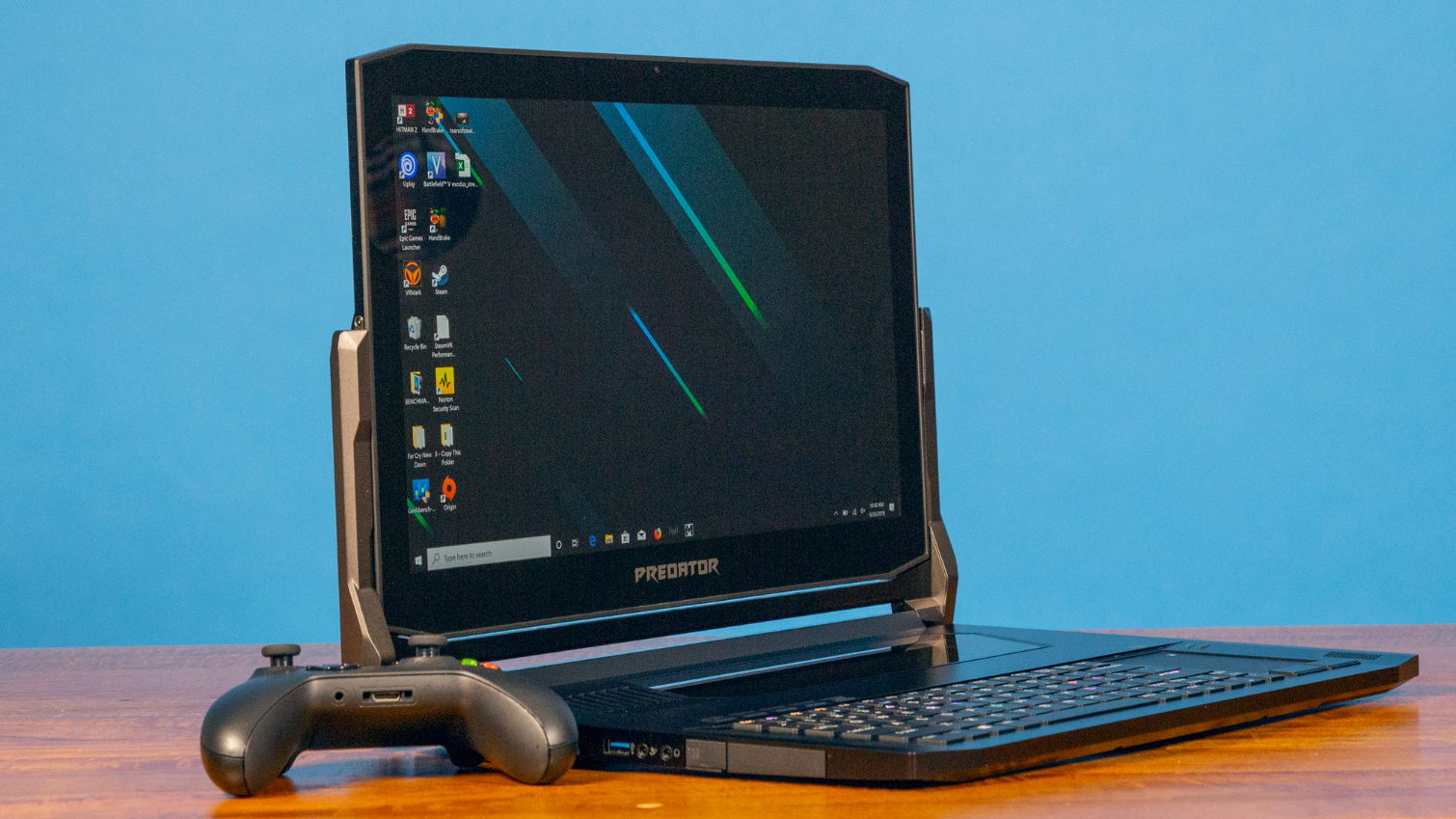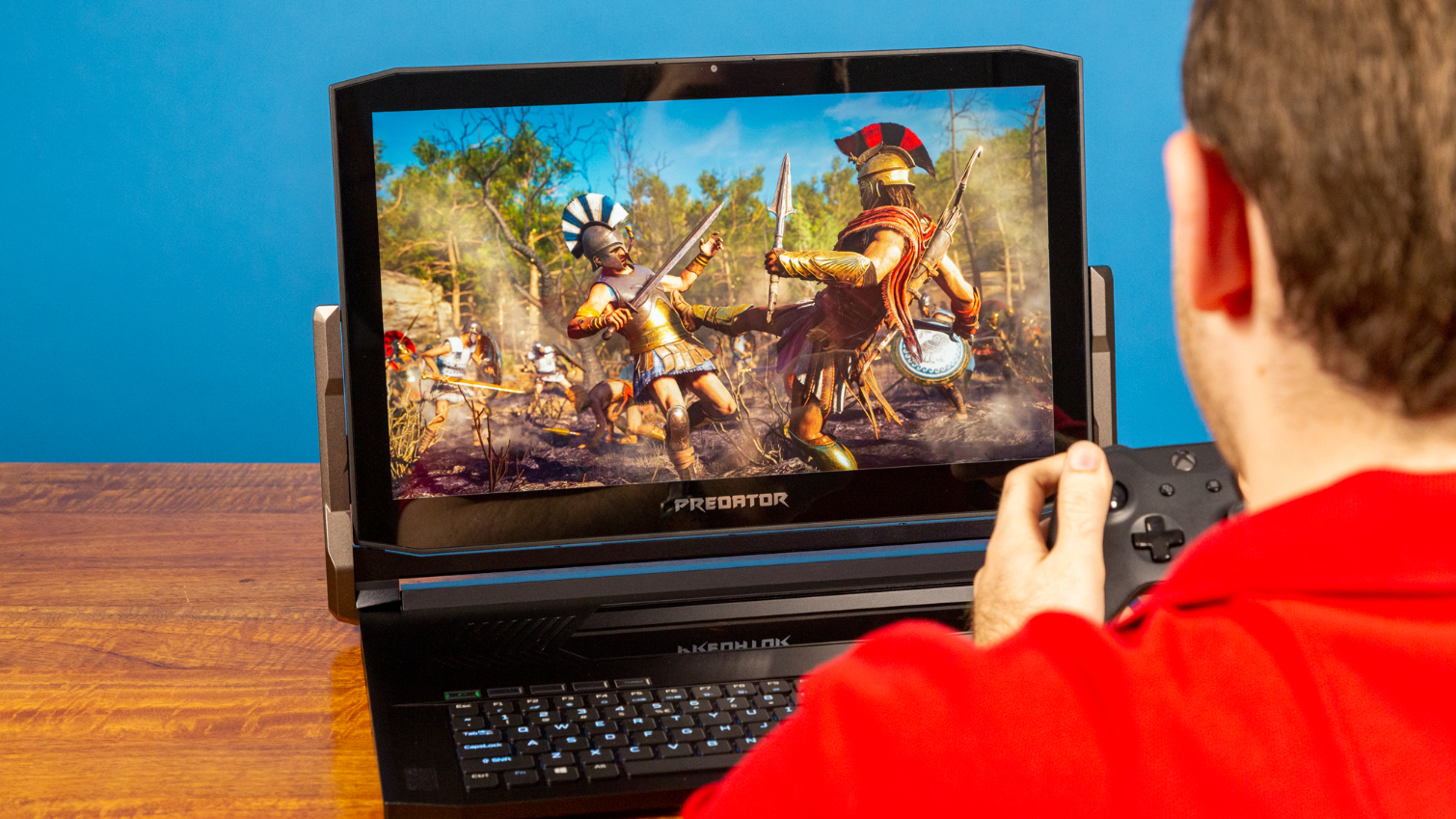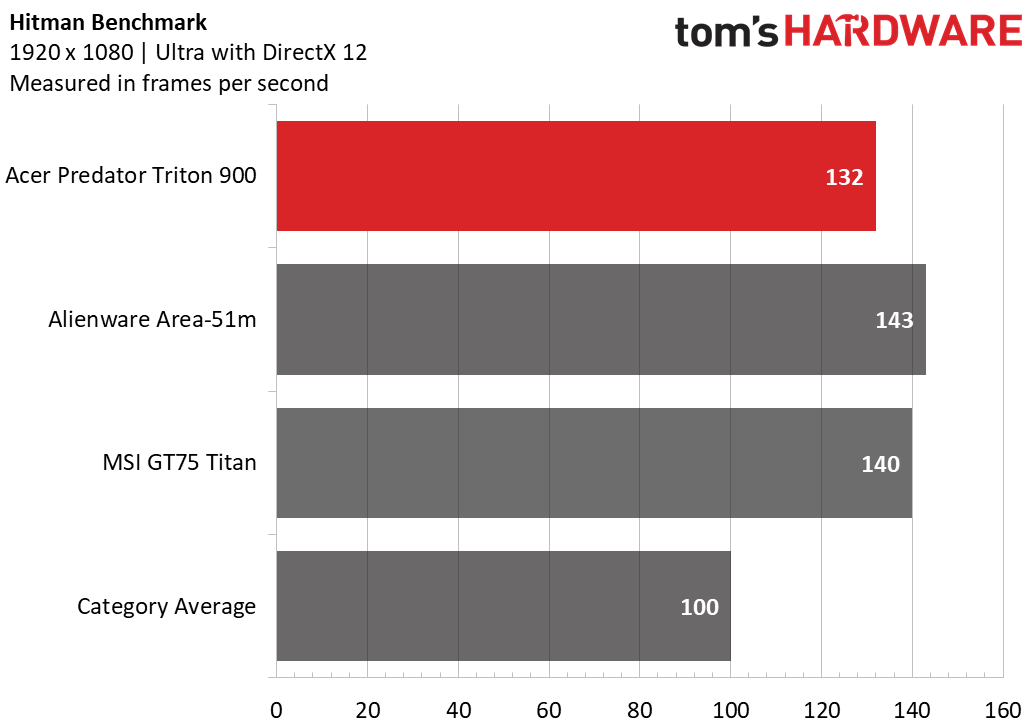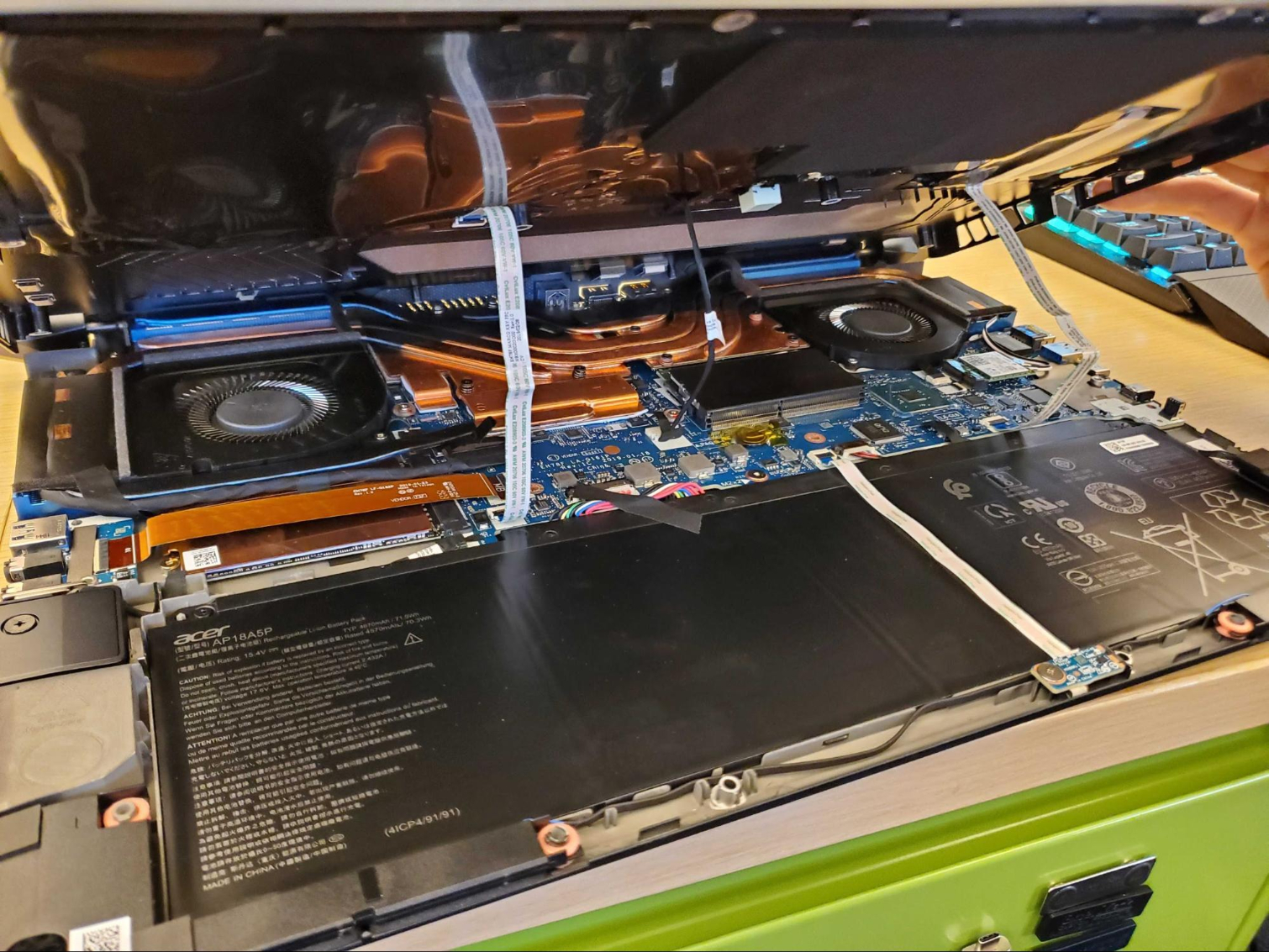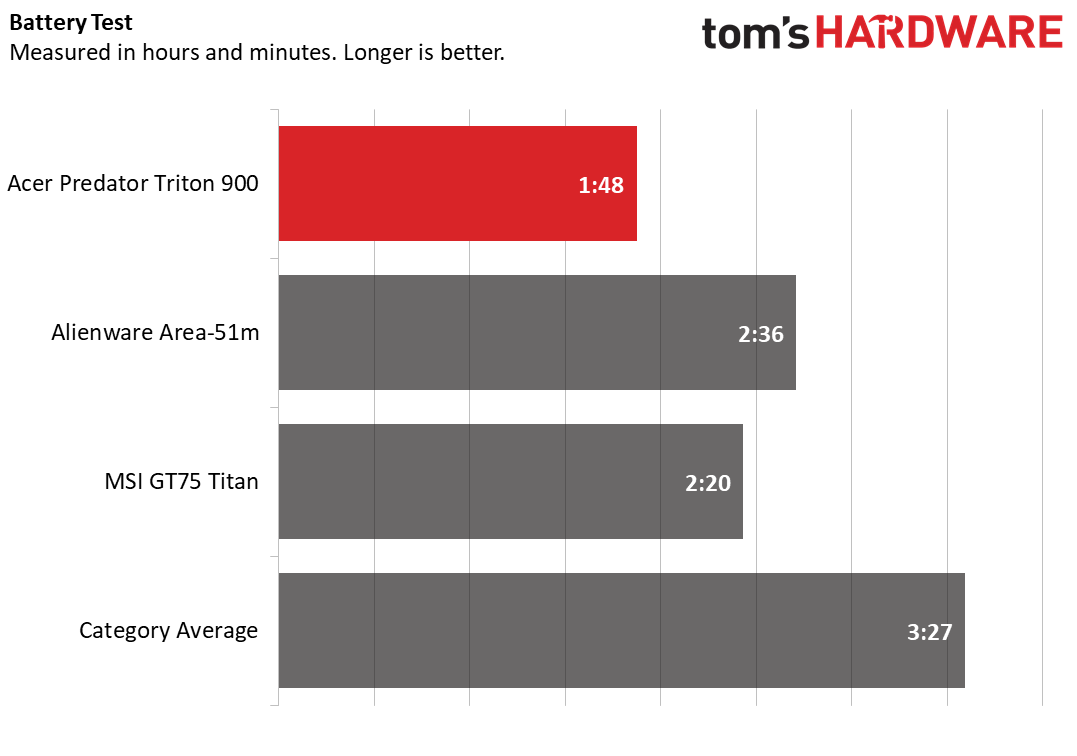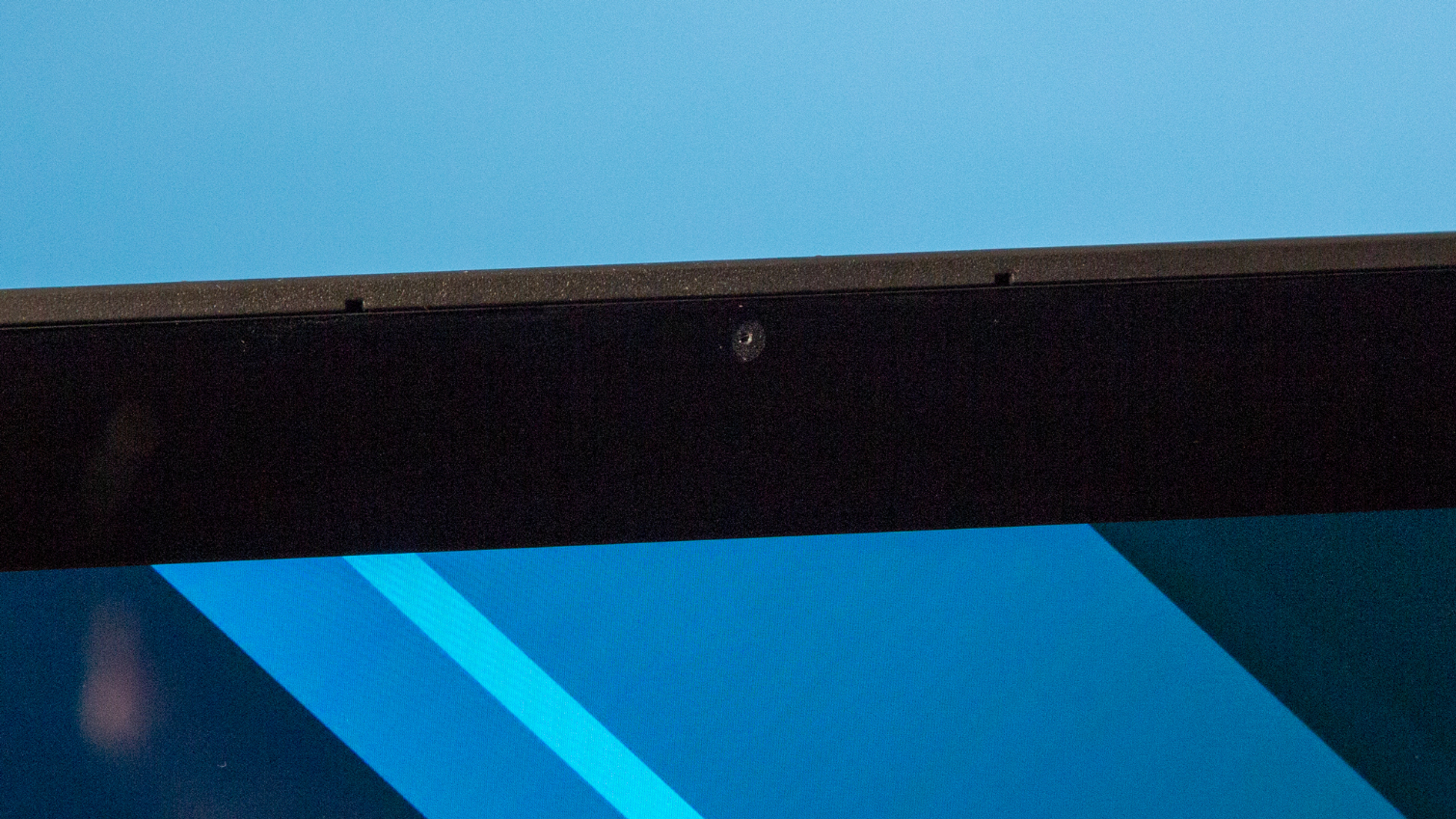Tom's Hardware Verdict
The Acer Predator Triton 900 is a big laptop with a unique hinge, but has an awkward keyboard and isn’t as easy to upgrade as other laptops.
Pros
- +
Unique hinge design
- +
Powerful specs
- +
Beautiful display
Cons
- -
Awkward, uncomfortable keyboard
- -
Hard to upgrade
Why you can trust Tom's Hardware
Acer hopes to flip the gaming laptop script by flipping the screen. The Acer Predator Triton 900 ($3,799.99, £3,999.99 in the UK) has a unique design in which the display sits on a hinge to be flipped around, brought forward or slipped into a giant, 17.3-inch, 9-pound tablet.
Even with that, the Triton is thin, but Acer has still packed in an Intel Core i7-9750H, an Nvidia GeForce RTX 2080 GPU, 32GB of RAM and two 512GB SSDs in RAID0. But that unique design has also made sacrifices. The keyboard is awkward, and upgradeability, while not by any means impossible, is harder than on other laptops.
That brings the decision down to two main questions: Do you want your 17.3-inch gaming laptop thin? Will you use its swiveling display? Those answers will make all the difference.
Design
The Triton 900 is a tank. The 9-pound laptop has an entirely metal chassis (the lid and deck are aluminum, the bottom is magnesium alloy). The lid, like the rest of the laptop, is a very, very dark gray and has a a mix of sharp and rounded edges, along with a silver Predator logo surrounded by a bright blue outline. It looks kind of like a knockoff Decepticon logo and has the word “Predator” in all caps below it. Even with the laptop closed, it’s hard to miss the two hinges affixed to the top of the chassis.
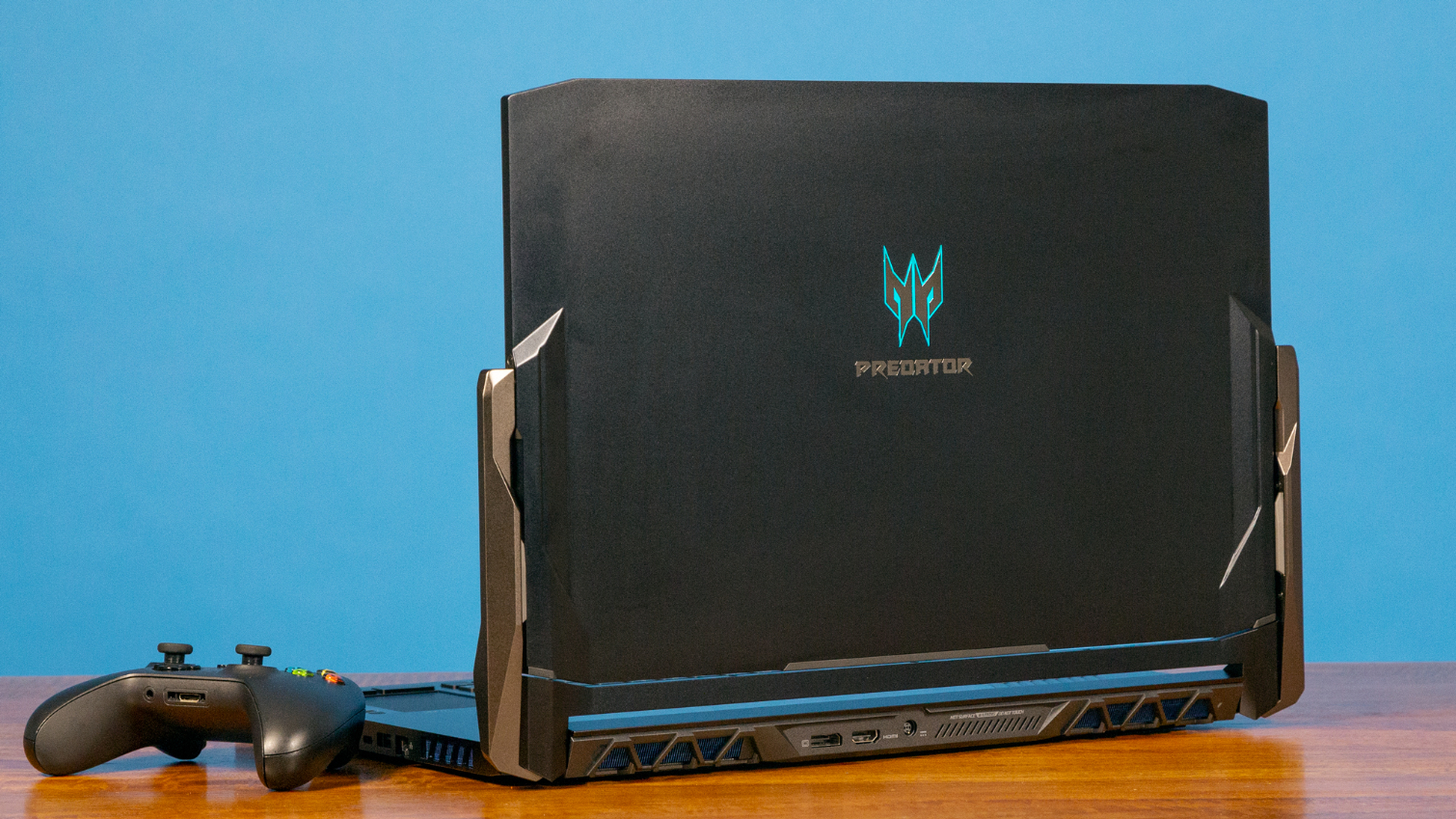

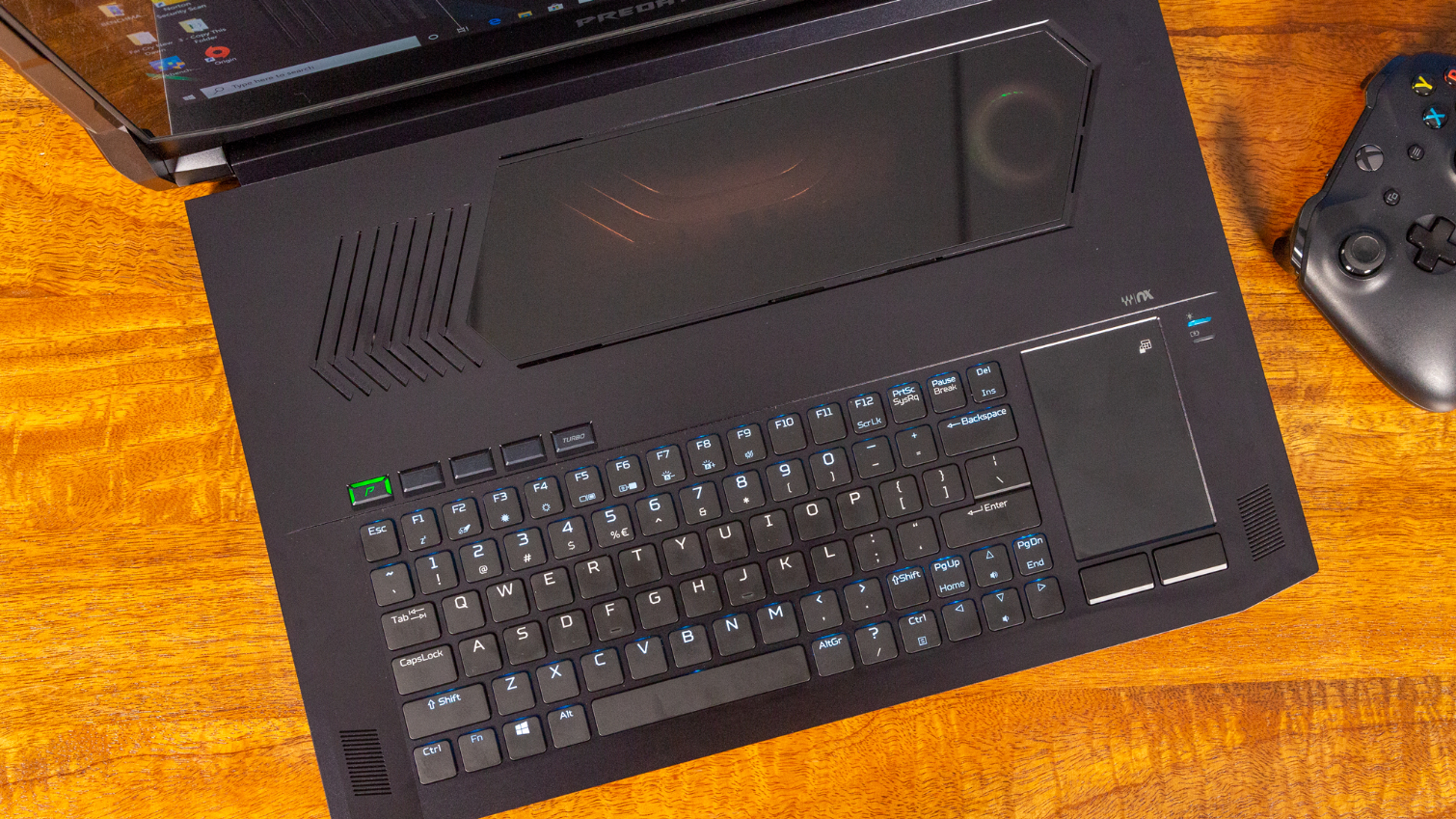
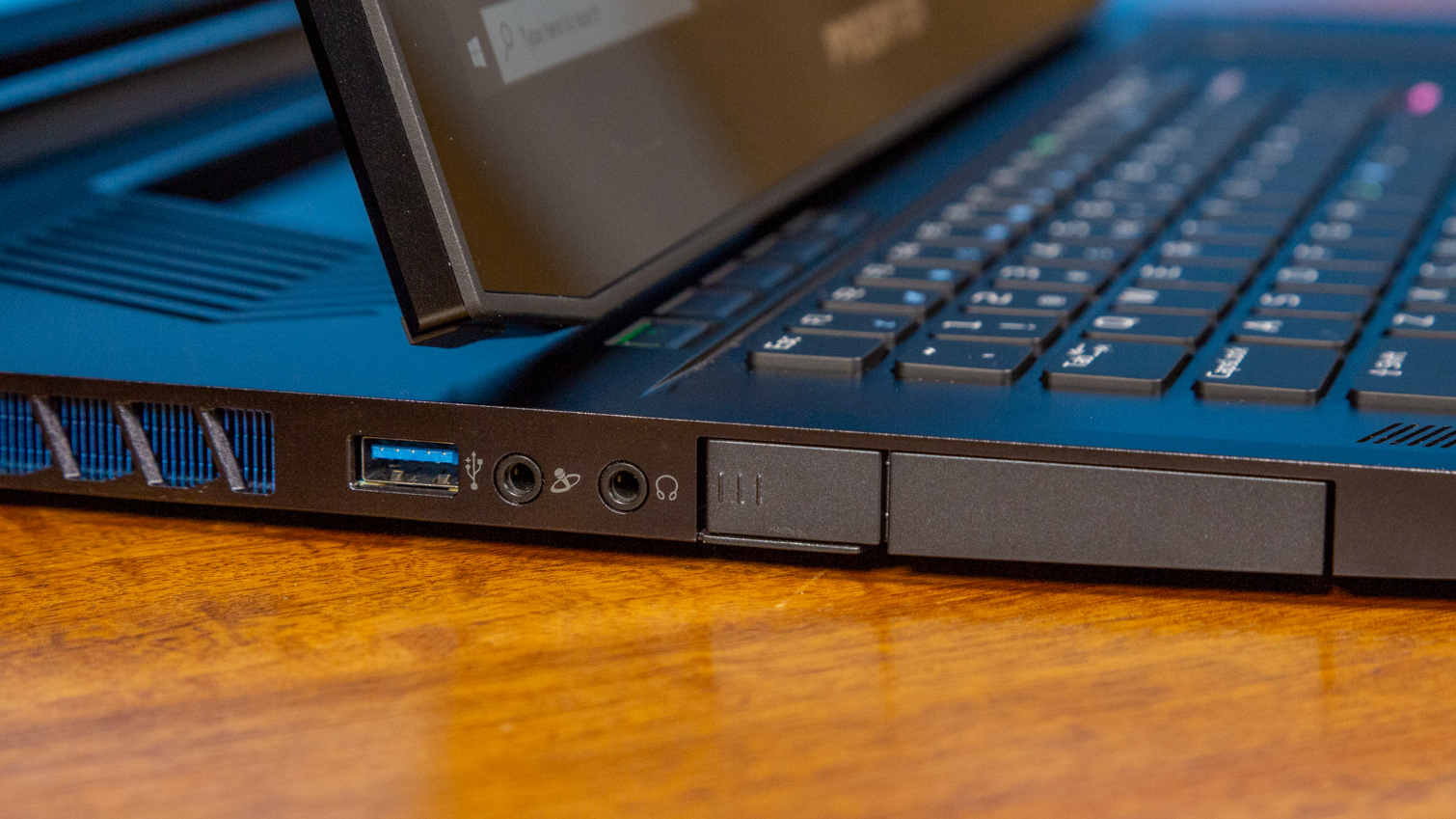
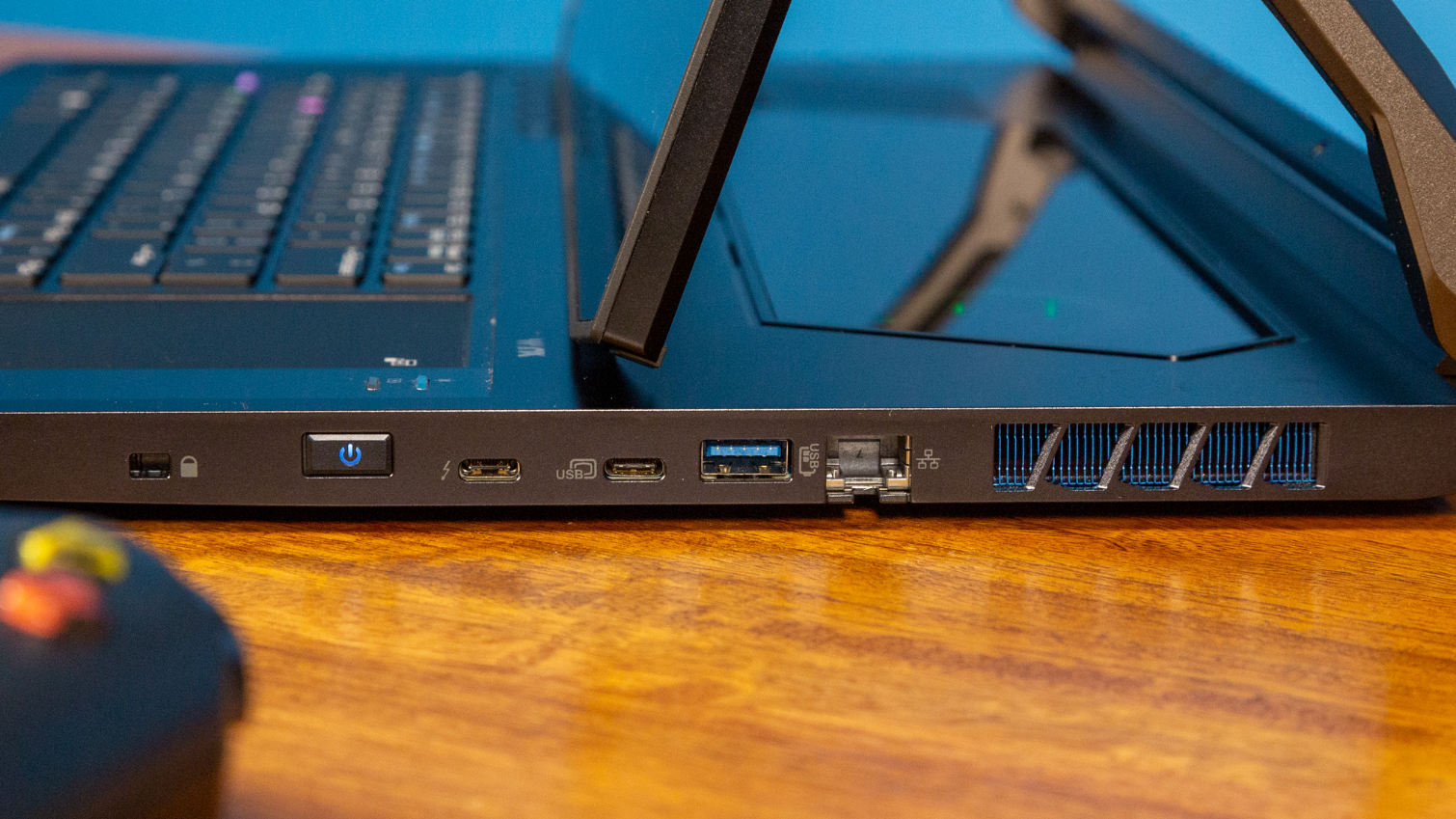
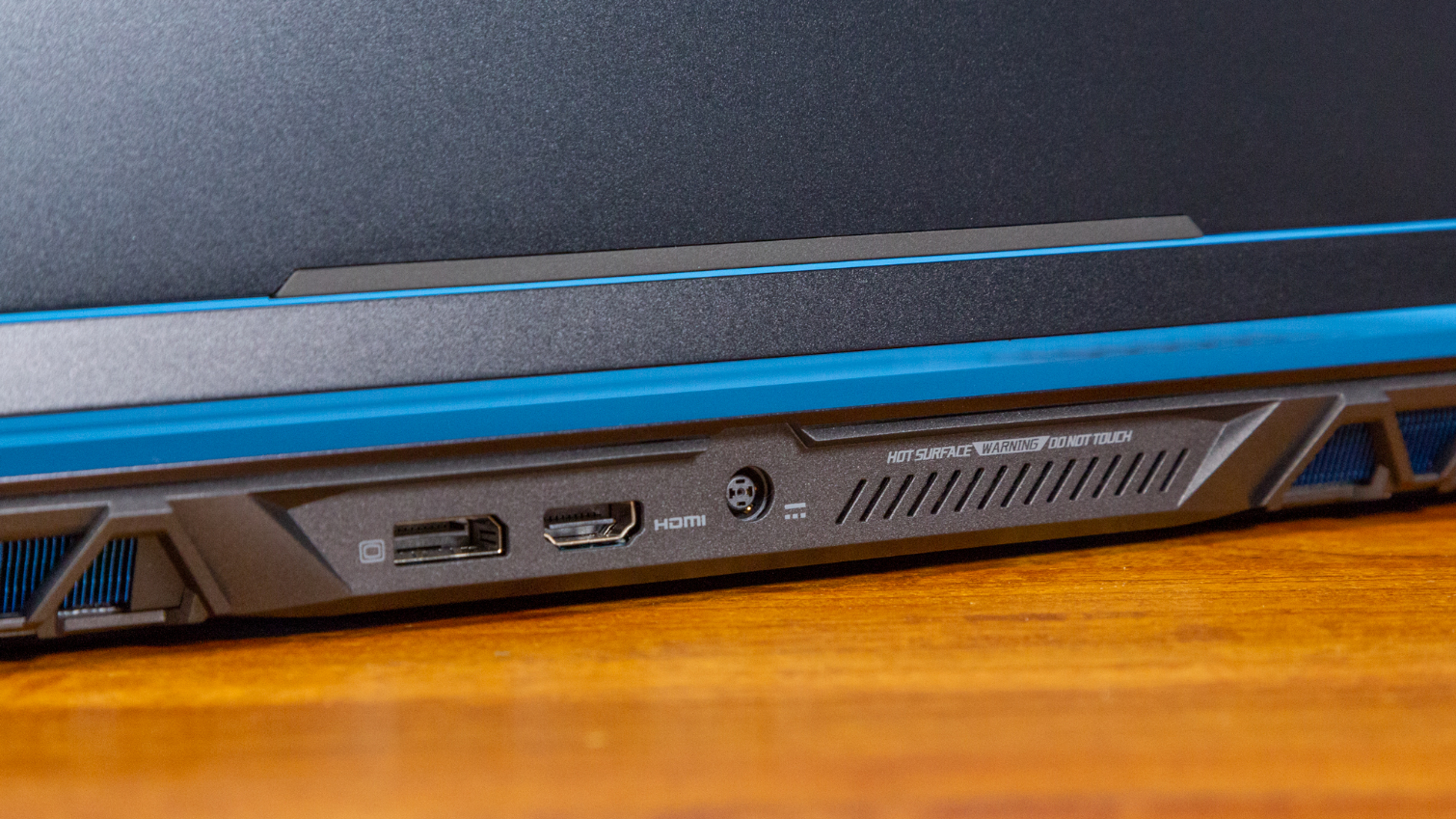
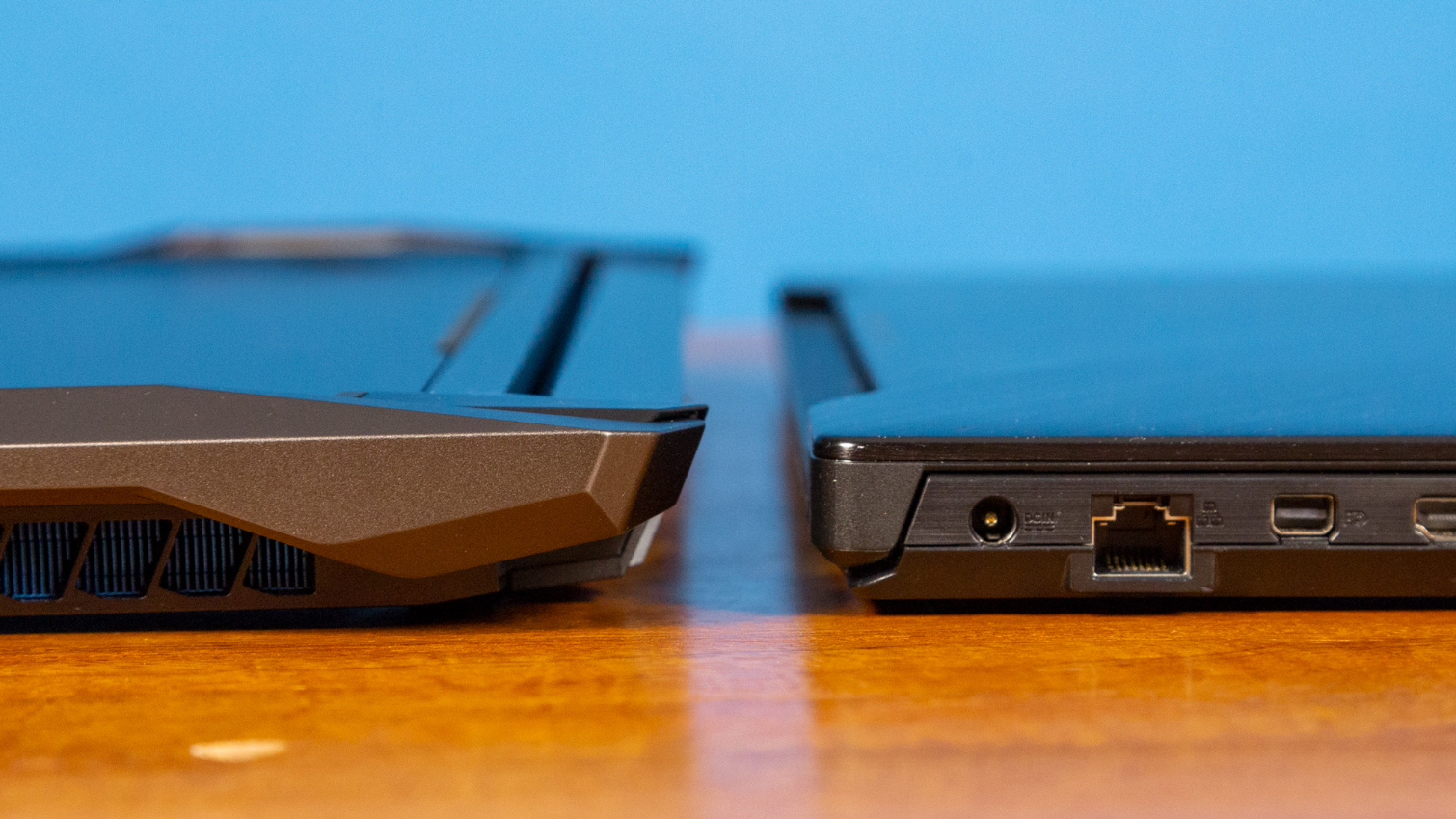
The purpose of the hinges, which Acer has dubbed the Ezel Aero Hinge, is more apparent when you lift the laptop’s lid. The hinge’s arms flank the 17.3-inch 4K G-Sync screen, so that it can be pushed right behind the RGB keyboard or laid flat into a tablet. You can also flip the screen into laptop mode to use it more like a television (this could be good if you’re using a controller and don’t want to see the keyboard).
That design, while innovative, is questionable for a gaming laptop. If you’re a creative, perhaps using the laptop for photo or even video editing with a stylus, (which does not come in the box), tablet mode could have some use. A photo workflow powered by a Core i7 and RTX 2080 could be quite fast. But other than trying tablet mode out, I tended to stay in regular laptop mode during use. One could think of this design as a Surface Studio built for gaming, to questionable results.
The keyboard is on the very front of the deck (I wish the Triton came with a wrist rest), and the touchpad is to the right with a pair of click buttons. A touch-sensitive toggle turns the touchpad into a touch-based number pad.
Get Tom's Hardware's best news and in-depth reviews, straight to your inbox.
Moving the keyboard, however, has made extra room for cooling. There are some vents above the keyboard’s macro keys, as well as a dark tinted window that shows off some of the heat pipes and a fan, which has lights that can be controlled in the PredatorSense app.
A laptop this thick has plenty of room for ports. For example, the left side of the laptop has a USB 3.1 Gen 1 port, separate headphone and microphone jacks and an odd USB 2.0 port that swivels out and has a very large cover that fits into the side panel. Acer tells me this is meant to be used for an Xbox Wireless Adapter (though newer Xbox One controllers can connect via Bluetooth), which is sold separately. If you don’t use it, it’s always just another USB 2.0 port.
On the right side are a Noble lock slot, Thunderbolt 3, USB 3.1 Type 1 and an Ethernet port. There are more ports on the back: a DisplayPort, HDMI and the power jack.
At 9 pounds, 11.9 inches wide and 0.9 inches thick, the Predator is heavier but thinner than the 8.5-pound, 1.7-inch thick, Alienware Area-51m, a gaming laptop with desktop-class components and some upgradeability, but lighter than MSI’s 10-pound powerhouse, the 2.3-inch thick, GT75 Titan.
Specifications
| CPU | Intel Core i7-9750H |
| Graphics | Nvidia GeForce RTX 2080 (8GB GDDR6) |
| Memory | 32GB (2x 16GB) DDR4-2666MHz |
| SSD | 2x 512GB PCIe M.2 SSD in RAID 0 |
| Display | 17.3-inch 4K with Nvidia G-Sync |
| Networking | Ethernet jack, Killer Wireless 1550 2x2 AC, Bluetooth 5.0 |
| Video Ports | HDMI, DisplayPort |
| USB Ports | 2x USB 3.1 Gen 1, USB 2.0, Thunderbolt 3, USB 3.1 Gen 2 Type-C |
| Audio | 4x stereo speakers, headphone jack, microphone jack |
| Camera | 1920 x 1080 |
| Battery | 72Whr |
| Power Adapter | 330W |
| Operating System | Windows 10 Home |
| Other Features | Ezel Aero Hinges |
| Dimensions (WxDxH) | 16.9 x 11.9 x 0.9 inches / 429.3 x 302.3 x 22.9mm |
| Weight | 9 pounds / 4.1kg |
| Price (as configured) | $3,799 |
Gaming, Graphics and VR
For gaming, the Triton packs an Nvidia GeForce RTX 2080 with 8GB of GDDR6 VRAM, which makes for a powerful gaming experience. When I played Battlefield V at 1920 x 1080 on ultra settings (including DXR ray tracing at ultra), it ran, for the most part, between 80 and 101 frames per second (fps), with the exception of a few sudden dips into the 60s during heavy action sequences.
On the Rise of the Tomb Raider benchmark (FHD, very high), the Triton 900 played the game at 83 fps, beating the premium gaming laptop average of 62 fps and faster than the Titan, but the Area-51m was speedier at 92 fps. Both of the other laptops also carry RTX 2080 GPUs. At 4K resolution, the Triton dipped to 26 fps on the same settings.
It was a similar pattern on Hitman (1920 x 1080, ultra), in which the Triton hit 132 fps, beating the 100-fps average, though in this case it lost to both the Titan and the Area-51m. At 4K on the same settings, the Triton ran Hitman at 66 fps.
The Triton performed well on the Grand Theft Auto V benchmark (FHD, very high), with an average of 106 fps, easily beating the 76-fps average. It’s a frame ahead of the Area-51m and far beyond the Titan. This was still playable at the same settings on Acer’s laptop, even when boosted to 4K, at 32 fps.
The Triton 900 earned a score of 11 on the SteamVR performance test, which is as high as a machine can get, so this should work with VR headsets like the Oculus Rift and HTC Vive, provided you have enough ports for your setup.
To really stress test the Triton, I ran the Metro: Exodus benchmark 15 times in a row on the RTX preset, simulating roughly half an hour of gaming. Across the 10 runs, the game ran at an average of 60.8 fps. The first two runs were just over 61 fps, and several runs were around 60.5 fps before bounding back up by run 11.
During the test, the CPU ran at an average clock speed of 3.8 GHz and measured an average temperature of 85.3 degrees Celsius (185.5 degrees Fahrenheit). The GPU operated an average temperature of 70 degrees Celsius (158 degrees Fahrenheit).
Productivity Performance
The Triton’s GPU isn’t the only powerful component in the laptop. It's also has an Intel Core i7-9750H CPU paired with 32GB of RAM and two 512GB PCIe SSDs in RAID 0.
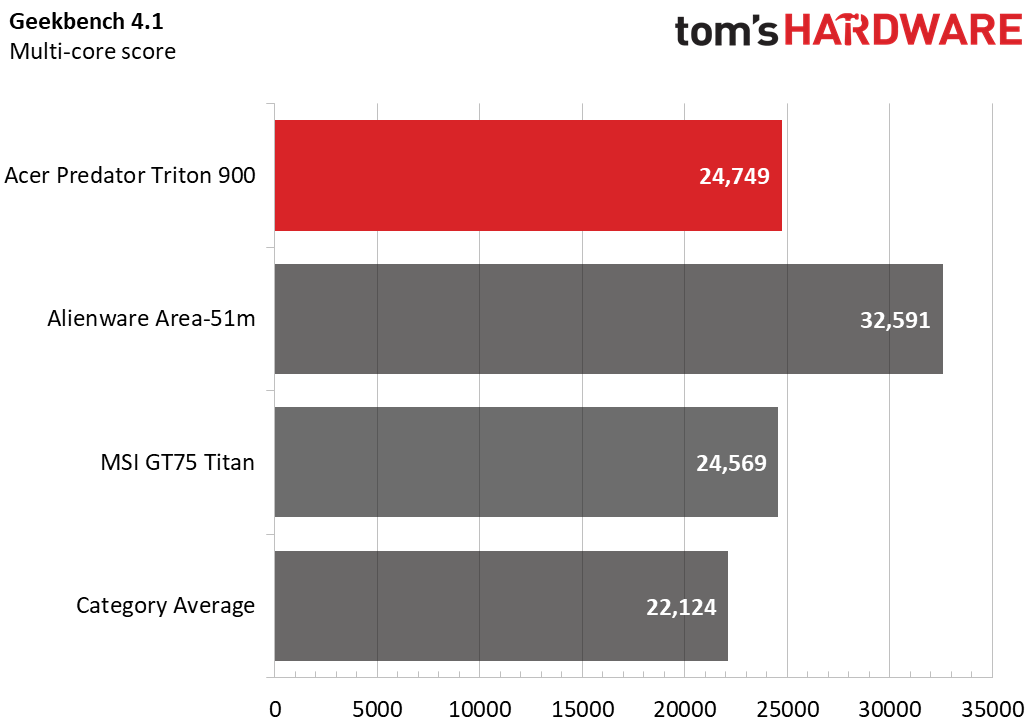


On Geekbench 4.1, the laptop earned a score of 24,749, beating the premium gaming average (22,124) and the Titan (i9-8950HK), but not the Area-51m. That last laptop, however, boasts a desktop-class Intel Core i9-9900K, which gives it a leg up in most of the productivity benchmarks.
It took the Triton just six seconds to transfer 4.97GB of files, a rate of 848.2 MBps. That’s equal to the Titan and faster than the average (701.9 MBps). The Area-51m was faster at a blazing 1,272.3 MBps.
The Predator Triton took 9 minutes and 55 seconds to complete our Handbrake video editing test, in which the laptop converts a 4K video to 1080p. And while that’s faster than average (10:10), the Titan did it in 8 minutes and the Area-51m, again, with a desktop processor, took 6 minutes.
Display
The 17.3-inch 4K G-Sync display on the Triton 900 is mammoth. The large bezels around the screen definitely make it feel less immersive than it could to play games on it. But it’s also bright and vivid. The colors are impressive; however, the screen is reflective, so you’re best off using it in darker areas. Still, the trees lining a street in 4K film Tears of Steel were a lush shade of green, and one character’s red, threadbare clothing popped against the brown rags of others in the scene.
It also looked great when I played Battlefield V. The blue skies of Norway shined brightly as I skied down snowy slopes.
The laptop covers 167% of the sRGB color gamut, beating the premium gaming average (146%) and the Area-51m (118%), but less than the Titan (178%).
But the Triton is brighter than all other comers at 324 nits, beating the average (287 nits), the Area-51m (284 nits) and the Titan (271 nits).
Keyboard and Touchpad
The RGB keyboard on the Triton is a fascinating case study in how a low-profile keyboard can work on a gaming laptop. It’s set very low on the deck, and I wish Acer would have shipped a wrist rest with the laptop. Acer calls the keys “mechanical,” though it does not name a specific kind of switch.
Those keys, offer a satisfying click, but with 70 grams of force required to actuate them, they feel mushy while typing. On the 10fastfingers.com typing test, I hit 90 words per minute (about 25 words slower than I usually do) with a 6% error rate, rather than my usual 2%.
Part of that was because of the ill-designed right shift key. It’s the size of a single letter key cap and placed next to the period and comma and above the question mark. One of my biggest issues on the test and with the keyboard in general was missing capital letters all of the time.
When I was done typing, my wrists hurt. Did I mention I wish this shipped with a wrist rest?
The 2.4 x 3.6-inch touchpad is set to the right of the keyboard, with two click buttons below it. It’s a little small on the horizontal plane and can be a bit of a squeeze for certain Windows 10 gestures. But it’s a Windows 10 precision touchpad, so when I jammed four fingers on the touchpad it pulled up the Notification Center. Other gestures, like opening the timeline with a three-finger swipe up, also worked flawlessly.
A touch-sensitive calculator icon in the top right-hand corner of the touchpad turns the whole thing into a touch-based number pad. The numbers light up, as do an enter button and arithmetic symbols. Strangely, the button to launch PredatorSense is also there, and it seems odd to keep that hidden when you’re using the touchpad.
But my bigger issue with the feature is that the switch didn’t always occur. I often found myself tapping furiously on the symbol and stuck with the number pad on when I didn’t need it (or vice versa).
Audio
Considering the size of the Triton, I was disappointed by the speakers inside it. They’re perfectly serviceable, but I had to play around to get the detail I expect at this price.
When I listened to Benny Blanco, Halsey and Khalid’s “East Side,” it filled our lab with sound, but the instruments were muddled below the vocals.
I had similar issues when I played Battlefield V. Again, it was perfectly usable, but the orchestral music was a little quiet, and vocals and gunshots were far more powerful.
I was able to make some tweaks to the sound with the pre-installed Waves MaxxAudio program and adjusted the bass and made the instruments more clear, but it’s not what I expect to have to do on a $3,799 laptop.
Upgradeability
The Triton 900 is far more interesting to open than other laptops I’ve tested. There are 12 Phillips head screws on the bottom, and those come out easily enough. But if you try to pry the base off now, you’ll notice that everything seems to be attached to it.
Instead, I flipped the whole system over and jimmied it off from the base. The motherboard is attached to the top casing by three ribbon cables, and you’ll need to remove those to do any meaningful upgrades.
The two 16GB DIMMs are easily accessible should you want to swap those out but are covered with a protective seal.
The pair of 512GB SSDs are under a copper heatsink covered by a ribbon cable, so there are some extra steps to expanding storage.
Battery Life
You won’t want to take this laptop anywhere without its bulky, 330W power supply. The Triton ran for 1 hours and 48 minutes on our battery test, which constantly browses the web, streams videos and runs OpenGL benchmarks at 300 nits.
That’s less than the premium gaming laptop average of 3:27 as well as both the Alienware Area-51m and MSI GT75 Titan.
Heat
When you’re not gaming, the Triton stays quite cool. After streaming 15 minutes of HD video from YouTube, the center of the keyboard between the G and H keys measured 29.9 degrees Celsius (85.8 degrees Fahrenheit), the touchpad was 28.7 degrees Celsius (83.7 degrees Fahrenheit) and the bottom hit 36.5 degrees Celsius (97.7 degrees Fahrenheit).


When I played Battlefield V, the 4th Gen Aero Blade 3D fans sped up because the machine got predictably hotter. The hottest part of the bottom reached 59.8 degrees Celsius (139.6 degrees Fahrenheit). The keyboard measured 42.4 degrees Celsius (108.3 degrees Fahrenheit), and the touchpad hit 43.8 degrees Celsius (110.8 degrees Fahrenheit).
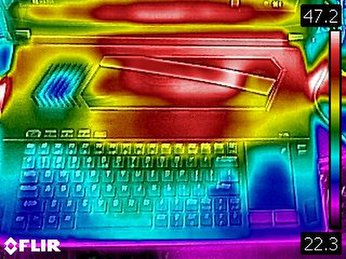
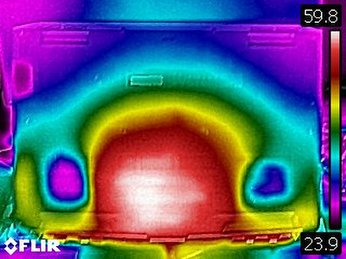
Webcam
The Predator Triton boasts a 1920 x 1080 camera, which is perfectly suitable for calls but a little off on color. In a photo I took at my desk, I noticed that it picked up the yellow and pink of fluorescent lighting much more than many other webcams I’ve tested (and far worse than in real life).
Still, it’s detailed enough that I could make out every hair on my head.
Software and Warranty
Even on a $3,799 desktop replacement, Acer can’t help but add a ton of bloatware that you’ll likely spend time uninstalling.
There is a highlight: Acer PredatorSense, which lets you see how your system is performing, set overclocking settings and change macros and RGB colors on the keyboard and fan.
Firefox is preinstalled with an Acer affiliate link in the URL when you open it. The company also added Netflix, GoTrust ID, PhotoDirector for Acer, PowerDirector for Acer, Norton Security Scan and the Acer Collection, which lets you download and buy even more partner apps.
And that’s on top of all of the bloat built into Window 10, like two separate versions of Candy Crush, Asphalt Street Storm Racing, Gardenscapes and Hotspot Shield VPN.
Acer sells the Triton 900 with a 2-year warranty.
Configurations
The Triton 900 I reviewed is the base model and runs for $3,799.99 for an Intel Core i7-9750H CPU, Nvidia GeForce RTX 2080 with 8GB of GDDR6 VRAM, 32GB of DDR4 RAM, two 512GB PCIe SSDs in RAID 0 and a 4K G-Sync touch screen.
For a cool $3,999.99, Acer doubles the storage to two 1TB SSDs. The top-end model, at $4,299.99, is identical to the model we reviewed, except it uses Windows 10 Pro instead of Home.
Bottom Line
It’s a bit hard to vouch for the Triton 900’s design. It’s perhaps overengineered for gaming, though there is some use if you need your creative work powered by top-of-the-line laptop specs. But if you’re buying a $3,799.99 gaming machine, you’ll probably use it as a clamshell most of the time.
That being said, this thing is powerful. It’s only sold in entirely pimped out configurations and will play anything you throw at it. The display is beautiful, albeit surrounded by giant bezels.
The big downsides are that the keyboard, though innovative in some ways, is shallow, laid out in an odd fashion and hurts to use without a wrist rest, which isn’t included in the box. Upgrading is possible, but harder than in some competing laptops.
But anything else maxed out will likely be more expensive, as both of our competitors were. If you have some more cash, the Alienware Area-51m is far better for tinkerers, but is expensive maxed out. As of this writing, a $4,149.99 configuration has an i9-9900K desktop CPU, RTX 2080 and is otherwise similarly specced, as well as offering eye tracking and more storage.
But that’s a huge machine, and the Triton is thin. So if you can get past the keyboard and don’t care to upgrade (or have the stomach for it), it may be right for you.
Photo Credits: Tom's Hardware
MORE: Best Gaming Laptops
MORE: Laptop Reviews
MORE: All Laptop Content

Andrew E. Freedman is a senior editor at Tom's Hardware focusing on laptops, desktops and gaming. He also keeps up with the latest news. A lover of all things gaming and tech, his previous work has shown up in Tom's Guide, Laptop Mag, Kotaku, PCMag and Complex, among others. Follow him on Threads @FreedmanAE and BlueSky @andrewfreedman.net. You can send him tips on Signal: andrewfreedman.01
